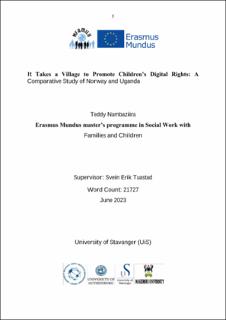| dc.description.abstract | Children's online presence has grown rapidly. Today, one in every three internet users is a child, with 93% of children online by the age of 12. Children now have more opportunities to broaden their horizons and fully exercise their digital rights and freedoms because of digitalization. These rights include both protective and participatory rights and are based on UN General Comment No. 25, which advocates for children's rights in the digital environment. Street-level bureaucrats are government employees tasked with promoting both protective and participatory rights. The fulfillment of children's rights is shaped by bureaucratic promotion strategies and challenges to rights promotion. However, different countries have different state capacities, resources, and policy implementation strategies, all of which have an impact on rights promotion. As a result, this study sought to examine existing promotion strategies and challenges in advancing children's digital rights faced by street-level bureaucrats in a comparative context between Norway and Uganda. Six interviews were conducted with six bureaucrats who were purposively chosen based on their professions using a comparative qualitative collective case study design. Three bureaucrats in Norway (1 social worker, 1 teacher, and 1 police officer) and three bureaucrats in Uganda (1 social worker, 1 teacher, and 1 police officer). The theoretical framework of the study was Lipsky's street level bureaucracy theory and Pogge's institutional conception of human rights. The findings revealed that bureaucrats in both countries used education and empowerment of children with digital skills as common promotion strategies. Through their support, parents were seen as enablers of both protective and participatory rights. Norway strives for a balance of protective and participatory rights, whereas Uganda prioritizes protective rights. In terms of bureaucratic roles, the results show that police in both countries are concerned with risk and control, whereas social workers and teachers empower children with digital skills, knowledge, and support regarding online experiences. Both countries face challenges such as limited resources, a generational digital divide, and difficulties navigating international laws and frameworks. The study concludes with recommendations that call for collaboration and harmonization of promotion strategies by street-level bureaucrats, with the UN supporting rights promotion in low-income countries if children's digital rights are to be realized. It is also necessary to bridge the generational digital divide. This will be accomplished through digital literacy programs and the development of a multilingual digital environment that encourages active participation by all individuals. | |
